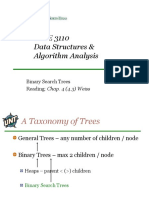write_a_program_to_implement_binary_search_tree
Uploaded by
dandambhaskarwrite_a_program_to_implement_binary_search_tree
Uploaded by
dandambhaskarWrite a program to implement Binary Search tree
CORRECT
Student: Gugulothu Vaishnavi Difficulty: EASY
Email: 23ag1a1227@gmail.com Score: 100%
23
23
23
ag
ag
ag
Question Description
1a
1a
1a
12
12
12
Problem Statement:
27
27
27
27
Write a program to implement Binary Search tree
@
@
Description: A Binary Search Tree (or BST) is a data structure used in computer science for organizing and storing data in a sorte
gm
gm
gm
gm
Input Format:
ai
ai
ai
ai
l.c
l.c
l.c
l.c
The first input is an integer n, representing the number of elements to insert into the BST.
om
om
om
om
The next n integers represent the elements to insert into the BST.
The last input is the key to search for in the BST.
23
23
23
Output Format:
ag
ag
ag
The in-order traversal of the BST, showing elements in sorted order.
1a
1a
1a
Print the index of the search element or -1 if it's not found.
12
12
12
Sample Input:
27
27
27
27
5
@
@
30
gm
gm
gm
gm
10
ai
ai
ai
ai
l.c
l.c
l.c
l.c
20
om
om
om
om
40
50
23
23
23
40
ag
ag
ag
Sample Output:
1a
1a
1a
10 20 30 40 50
12
12
12
3
27
27
27
27
Explanation:
@
@
The elements [30, 10, 20, 40, 50] are inserted in the BST, and an in-order traversal yields the sorted order 10 20 30 40 50.
gm
gm
gm
gm
The key 40 is found in the BST at index 3.
ai
ai
ai
ai
l.
l.
l.
l.
co
co
co
co
Your Solution
m
m
1 #include <stdio.h>
23
23
23
2 #include <stdlib.h>
ag
ag
ag
3
1
1
a1
a1
a1
4 // Structure for a node in the Binary Search Tree
22
22
22
27
5 struct Node {
7
7
@
6 int data;
gm
gm
gm
gm
7 struct Node* left;
ai
ai
ai
ai
8 struct Node* right;
l.c
l.c
l.c
l.c
9 };
om
om
om
om
10
11 // Function to create a new node
23
23
23
12 struct Node* createNode(int data) {
ag
ag
ag
13 struct Node* newNode = (struct Node*)malloc(sizeof(struct Node));
1a
1a
1a
1
14 newNode->data = data;
22
22
22
27
15 newNode->left = newNode->right = NULL;
7@
7@
7@
@
16 return newNode;
gm
gm
gm
gm
17 }
ai
ai
ai
ai
18
l.
l.
l.
l.
co
co
co
co
19 // Function to insert a node into the BST
m
20 struct Node* insert(struct Node* root, int data) {
Case Output Errors Time Memory Status
#1 5 10 15 20 25 30 No errors 0.007s 1MB PASSED
-1
#2 10 20 30 40 50 No errors 0.008s 1MB PASSED
3
Language: C (GCC 9.2.0) | Generated: 12/13/2024, 7:50:56 PM
You might also like
- 9231 Parallel Teaching of A Level Mathematics and Further Mathematics (For Examination From 2020)100% (1)9231 Parallel Teaching of A Level Mathematics and Further Mathematics (For Examination From 2020)21 pages
- Unit III - Topic 4 - Binary Search Tree (Bst) (1)No ratings yetUnit III - Topic 4 - Binary Search Tree (Bst) (1)12 pages
- Data Structure and Algorithm (CS 302) : A. K. SiromoniNo ratings yetData Structure and Algorithm (CS 302) : A. K. Siromoni23 pages
- ETCS-209: DATA Structure Odd Semester 2020: Binary Search TreeNo ratings yetETCS-209: DATA Structure Odd Semester 2020: Binary Search Tree51 pages
- TCP2101 Algorithm Design & Analysis: - Binary Search Trees (BST)No ratings yetTCP2101 Algorithm Design & Analysis: - Binary Search Trees (BST)105 pages
- CSCE 3110 Data Structures & Algorithm Analysis: Binary Search Trees Reading: Chap. 4 (4.3) WeissNo ratings yetCSCE 3110 Data Structures & Algorithm Analysis: Binary Search Trees Reading: Chap. 4 (4.3) Weiss29 pages
- Lecture 9 20122022 020117pm 06122023 050120pmNo ratings yetLecture 9 20122022 020117pm 06122023 050120pm50 pages
- Lec11-Binary-Search-Trees-09092024-090505pm (2)No ratings yetLec11-Binary-Search-Trees-09092024-090505pm (2)48 pages
- Data Structures Lab 10 Binary Search TreesNo ratings yetData Structures Lab 10 Binary Search Trees25 pages
- Data Structure and Algorithm (CS-102) : Ashok K TurukNo ratings yetData Structure and Algorithm (CS-102) : Ashok K Turuk39 pages
- Vision Gate 2023 Pds Class 21 Binary Search Tree1701874364337No ratings yetVision Gate 2023 Pds Class 21 Binary Search Tree170187436433728 pages
- Immediate Download An Introduction To Computational Science Allen Holder Ebooks 2024100% (3)Immediate Download An Introduction To Computational Science Allen Holder Ebooks 202462 pages
- Https Login - Remita.net Remita RRR View-Rrr Details - Json X-Id o2UObkijwi0NW3fh7Ym+KANo ratings yetHttps Login - Remita.net Remita RRR View-Rrr Details - Json X-Id o2UObkijwi0NW3fh7Ym+KA1 page
- Jigs and Fixtures in Production A Systematic Literature ReviewNo ratings yetJigs and Fixtures in Production A Systematic Literature Review33 pages
- Environmentally-Aware and Energy-Efficient Multi-Drone Coordination and Networking For Disaster ResponseNo ratings yetEnvironmentally-Aware and Energy-Efficient Multi-Drone Coordination and Networking For Disaster Response17 pages
- [FREE PDF SAMPLE] Hidden in the Shadow of the Master The Model Wives of Cezanne Monet and Rodin First Edition Ms. Ruth Butler ebook full chapters100% (1)[FREE PDF SAMPLE] Hidden in the Shadow of the Master The Model Wives of Cezanne Monet and Rodin First Edition Ms. Ruth Butler ebook full chapters66 pages
- Daftar Sisa Stok Dan Obat Habis TerpakaiNo ratings yetDaftar Sisa Stok Dan Obat Habis Terpakai6 pages
- Oracle Global Human Resources Cloud 19B Administer: Import DataNo ratings yetOracle Global Human Resources Cloud 19B Administer: Import Data2 pages
- 200-PABX Alphatron AlphaConnect 48-128-Classic TechSpec Manual PDU 1-1-2016No ratings yet200-PABX Alphatron AlphaConnect 48-128-Classic TechSpec Manual PDU 1-1-20164 pages
- Errors and Suspense Account: Financial Accounting 2 Ms SubashiniNo ratings yetErrors and Suspense Account: Financial Accounting 2 Ms Subashini55 pages

























































































